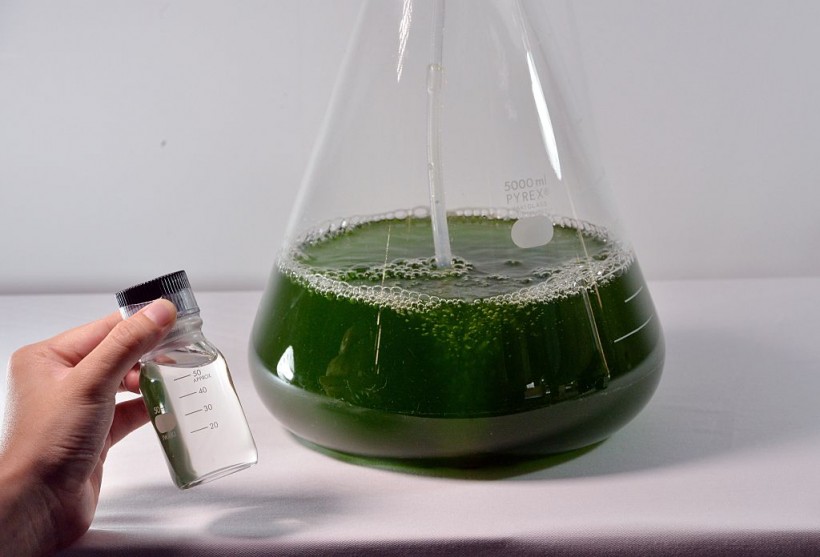Fish is a popular source of protein and omega-3 fatty acids, which are essential for human health.
However, the increasing demand for fish has led to overfishing, depletion of fish stocks, and environmental degradation.
Moreover, fish consumption may pose some risks due to the presence of contaminants such as mercury, dioxins, and microplastics in the aquatic environment.
Therefore, finding alternative sources of protein and omega-3 fatty acids that are sustainable, safe, and nutritious is a pressing challenge.
One of the potential alternatives is microalgae, which are microscopic aquatic organisms that can perform photosynthesis and produce biomass and various metabolites.
Microalgae have several advantages over fish as a source of protein and omega-3 fatty acids.
Microalgae as a source of protein and omega-3 fatty acids
 (Photo : YOSHIKAZU TSUNO/AFP via Getty Images)
(Photo : YOSHIKAZU TSUNO/AFP via Getty Images)

Microalgae are rich in protein and omega-3 fatty acids, which are important for human health.
Protein is a macronutrient that provides amino acids, the building blocks of muscles, tissues, enzymes, hormones, and antibodies.
Omega-3 fatty acids are polyunsaturated fatty acids that have anti-inflammatory, anti-thrombotic, and neuroprotective effects. They also play a role in maintaining cardiovascular health, brain function, vision, and the immune system.
According to Dr. Lena Kopp, a research associate at the Institute of Clinical Nutrition, microalgae can contain up to 70% of protein on a dry weight basis, depending on the species and cultivation conditions.
Some of the most commonly used microalgae for protein production are Spirulina, Chlorella, Scenedesmus, Nannochloropsis, and Arthrospira.
These microalgae have a high protein digestibility (up to 90%) and a balanced amino acid profile that meets or exceeds the requirements of the World Health Organization.
Microalgae can also produce significant amounts of omega-3 fatty acids, especially eicosapentaenoic acid (EPA) and docosahexaenoic acid (DHA), which are the most biologically active forms of omega-3 fatty acids.
EPA and DHA are mainly found in marine microalgae, such as Nannochloropsis, Phaeodactylum, Isochrysis, Pavlova, and Schizochytrium.
These microalgae can accumulate up to 40% of their dry weight as lipids (fats), with EPA and DHA accounting for up to 60% of the total fatty acids.
Also Read: Developing Microalgae Primarily for the Production of Biofuel
Microalgae cultivation and consumption
Microalgae can be cultivated in different ways, such as open ponds, photobioreactors, algal biofilms, or wastewater treatment systems.
The choice of the cultivation method depends on several factors, such as the microalgal species, the desired product, the environmental conditions, the cost-effectiveness, and the sustainability.
Some of the advantages of microalgae cultivation are:
- It can grow in saltwater or freshwater, using non-arable land and reducing freshwater consumption.
- Microalgae can use carbon dioxide as a carbon source, mitigating greenhouse gas emissions and enhancing carbon sequestration.
- It can utilize nutrients from wastewater or industrial effluents, improving water quality and reducing pollution.
- Microalgae can produce biomass and metabolites at a high rate and yield, compared to terrestrial crops or animals.
Microalgae can be consumed in different forms, such as whole biomass (fresh or dried), extracts (oils or proteins), or refined products (supplements or functional foods)
. Some examples of microalgal products that are available in the market are:
Spirulina powder or tablets
Spirulina is a blue-green microalga that has been used as a food supplement for centuries. It is rich in protein (up to 63%), beta-carotene (a precursor of vitamin A), iron, calcium, magnesium, and other minerals.
Spirulina has been shown to have antioxidant, anti-inflammatory, immunomodulatory, antiviral, and anticancerous properties.
Chlorella powder or capsules
Chlorella is a green microalga that is also high in protein (up to 58%), chlorophyll (a pigment with detoxifying effects), vitamins (B12), minerals (zinc), and dietary fiber.
Chlorella has been reported to have beneficial effects on blood pressure cholesterol levels blood sugar levels liver function wound healing.
Omega-3 oil from marine microalgae
Omega-3 oil from marine microalgae is a vegan alternative to fish oil that provides EPA and DHA without the risk of contaminants or the ethical issues of animal exploitation.
Omega-3 oil from marine microalgae has been proven to be effective in lowering triglycerides, improving cognitive function, and reducing inflammation.
Related article: Marine Microalgae: Food and Fuel of the Future
© 2024 NatureWorldNews.com All rights reserved. Do not reproduce without permission.

![Tsunami Hazard Zones: New US Map Shows Places at Risk of Flooding and Tsunamis Amid Rising Sea Levels [NOAA]](https://1471793142.rsc.cdn77.org/data/thumbs/full/70325/280/157/50/40/tsunami-hazard-zones-new-us-map-shows-places-at-risk-of-flooding-and-tsunamis-amid-rising-sea-levels-noaa.jpg)



